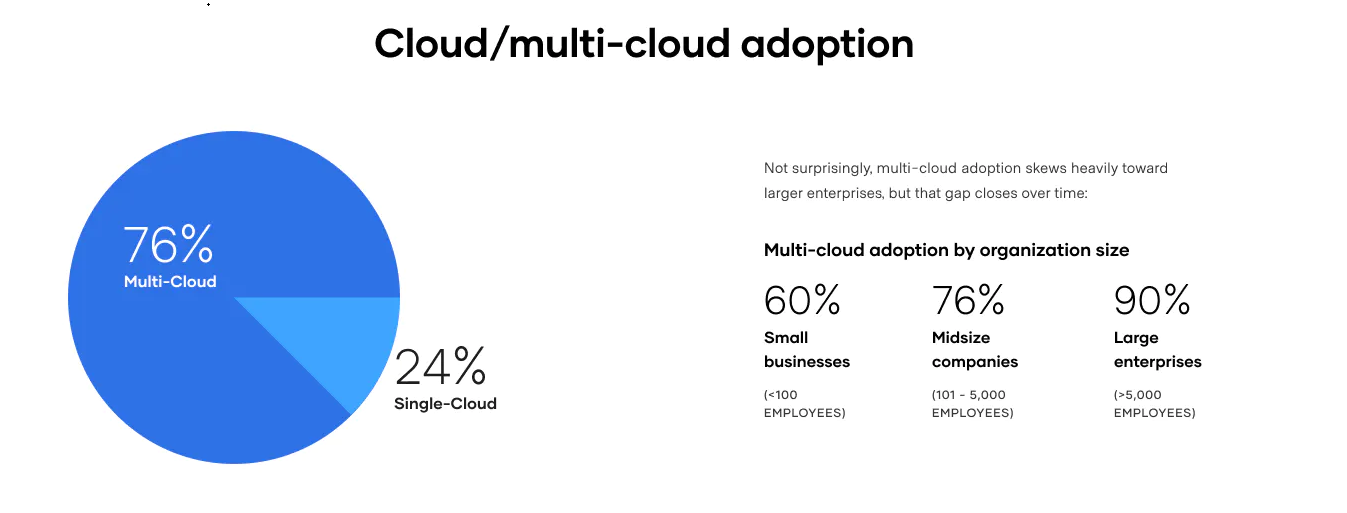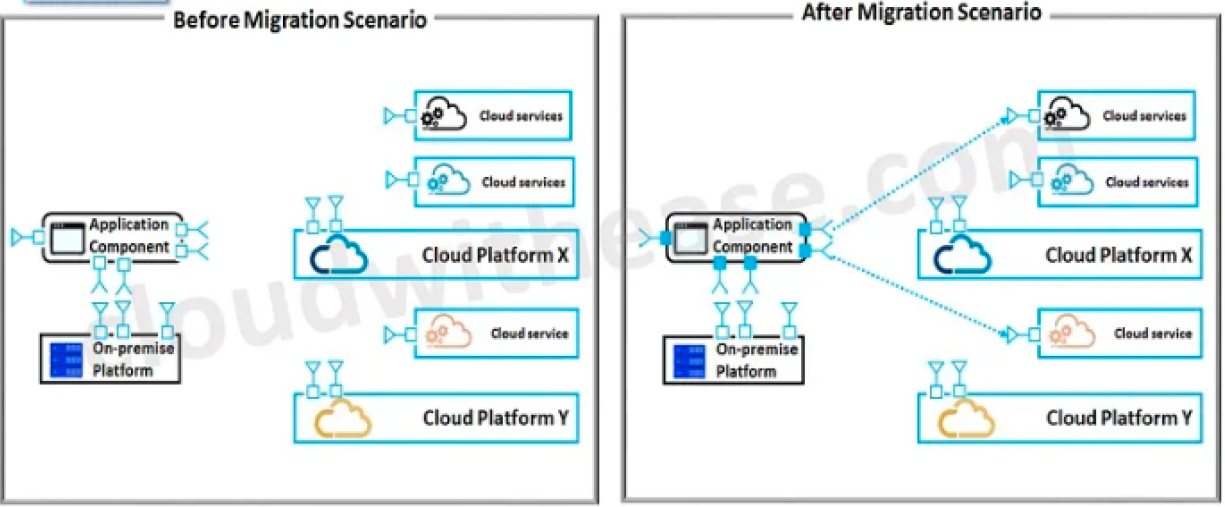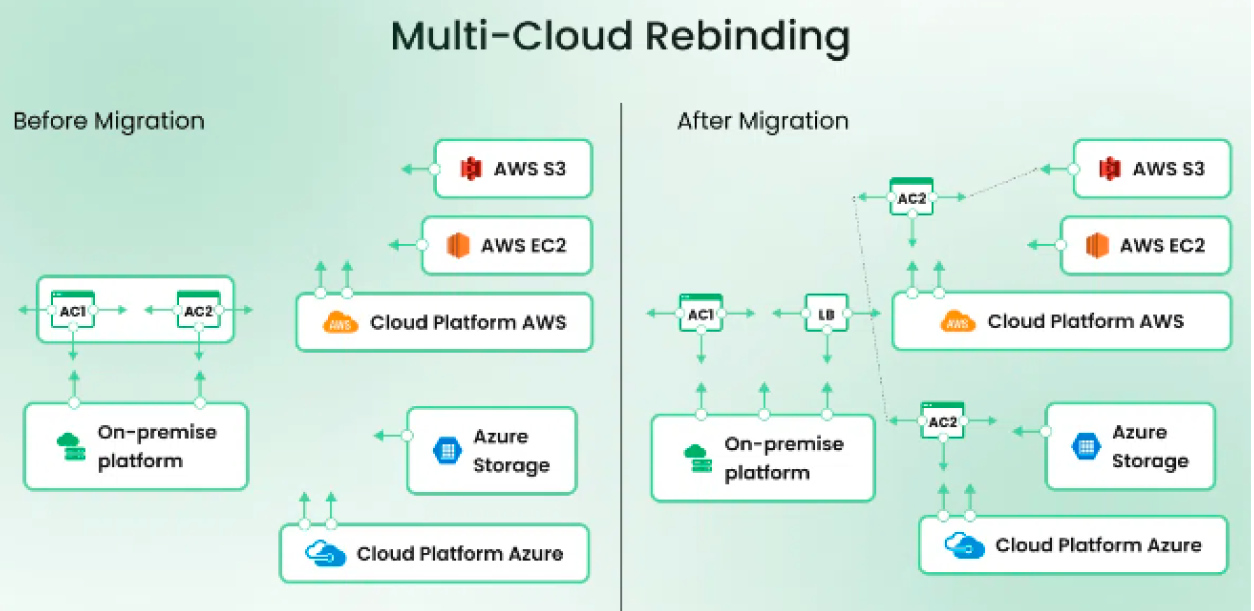Diversifying in the Cloud Age: A Deep Dive Into Multi-Cloud Architecture
Discuss the rise of multi-cloud architectures and how businesses are leveraging multiple cloud providers to improve redundancy, reduce risk, and enhance flexibility.
Join the DZone community and get the full member experience.
Join For FreeAs organizations undergo digital transformation, the scope of their software applications, data, and digital infrastructure undergoes a significant expansion. This results in the dispersion of workflows, teams, and data across various environments. Some elements remain within on-premise data centers, while others become scattered across multiple cloud service providers.
The adoption of multi-cloud architectures has become the prevailing trend for the present and future of most enterprises. Research indicates that over 90% of large organizations have already embraced multi-cloud architectures, with their data distributed among several cloud service providers.
The significance of multi-cloud strategies for businesses cannot be overstated. Beyond merely a technological trend, multi-cloud represents a fundamental shift in how enterprises leverage cloud resources to achieve their goals.
This article explores the rise of multi-cloud architectures and their impact on businesses. But first, let’s discuss what multi-cloud architecture is.
What Is a Multi-Cloud Architecture?
Multi-cloud architecture is an IT strategy where companies combine cloud services, such as Amazon Web Services, Microsoft Azure, private clouds, and on-site servers. This approach allows businesses to distribute their essential tasks, applications, and data across these diverse platforms.
In HashiCorp's first State of Cloud Strategy Survey, 76% of over 3,000 global respondents stated operating in multi-cloud environments.

This strategic versatility empowers organizations to handpick CSPs based on their distinct proficiencies, geographical coverage, performance excellence, security enhancements, or pricing structures. The outcome is a finely-tuned cloud environment that harnesses the unique strengths of each provider to address specific use cases, rectify vulnerabilities, and propel the attainment of business objectives.
Benefits of Multi-Cloud Architecture for Businesses
Let’s explore the benefits of multi-cloud architecture for businesses.
1. Enhanced Redundancy and Reliability
The multi-cloud architecture allows businesses to distribute their applications and data across cloud providers. In a failure or outage with one provider, services can seamlessly switch to another, ensuring high availability and minimizing downtime.
2. Risk Mitigation
Diversifying across multiple cloud providers reduces the risk of vendor lock-in. It allows businesses to choose providers with the best features and pricing, reducing dependency on a single provider and mitigating potential disruptions.
3. Cost Optimization
Multi-cloud allows cost optimization by leveraging competitive pricing and avoiding over-provisioning. Businesses can match workloads with the most cost-effective cloud provider, potentially saving costs.
4. Flexibility and Agility
Multi-cloud architectures provide the flexibility to quickly scale resources up or down based on changing business needs. It enables agile responses to dynamic workloads and market demands, fostering innovation and growth.
5. Reduced Vendor Lock-In
Another benefit of multi-cloud architecture is the reduced risk of vendor lock-in. By utilizing multiple cloud providers, businesses can avoid becoming overly dependent on a single provider's proprietary services, making it easier to switch providers or integrate new ones without significant disruption.
Multi-Cloud Architecture Designs
To develop applications that can scale extensively and offer high reliability, it's fitting to consider a multi-cloud architecture design.
Here, we will explore notable multi-cloud architectural approaches and strategies for the migration process.
1. Cloudification
When discussing the design of multi-cloud architectures, "cloudification" takes a prominent position. Within this architectural approach, application components are initially hosted on-premises. Nevertheless, these components can harness various cloud services from different platforms after migration, enhancing their overall performance.

2. Multi-Cloud Relocation
Multi-Cloud Relocation entails physically or virtually moving applications and data from one cloud provider to another, often to achieve specific objectives such as cost reduction, improved performance, or compliance adherence.

3. Multi-Cloud Refactor
This approach involves restructuring and optimizing applications and workloads to function efficiently across multiple cloud providers. It focuses on adapting existing software to leverage the advantages of diverse cloud environments.

4. Public-Private Multi-Cloud Architecture
The architecture primarily segregates servers into two categories: those operating within a private and public cloud. In this setup, the private cloud incorporates a firewall to ensure robust security, regulating access and permitting the sharing of only essential elements.

5. Multi-Cloud Rebinding
It involves deploying re-architected applications within a multi-cloud environment, ensuring the application's continuity by seamlessly switching to an alternative deployment if the primary source encounters a failure.

6. Multi-Cloud Rebinding With Cloud Brokerage
This concept involves using a cloud brokerage service to facilitate the seamless integration and management of multiple cloud providers within a multi-cloud architecture. The broker acts as an intermediary, optimizing cloud resource selection and use.

7. Multi-Application Modernization
Multi-Application Modernization is a strategy that involves concurrently updating and enhancing various applications, often in a multi-cloud environment. It aims to modernize multiple software solutions to meet contemporary performance, security, and scalability standards.

Navigating the Multi-Cloud Landscape
Multi-cloud computing represents a new frontier for IT professionals. In recognition that a single cloud provider may not perfectly align with all their needs, enterprises are increasingly adopting a multi-cloud approach, using multiple providers and cloud services to regain control over their digital infrastructure.
1. Selecting Providers for Multi-Cloud
Selecting the right providers for a multi-cloud environment can be equally, if not more, challenging than choosing a single cloud provider. IT professionals must meticulously evaluate vendors to determine which ones offer the needed services while staying within budget constraints.
It's important to remember that even after selecting a provider, there's no need to establish permanent roots. Continual assessment of chosen providers is crucial, and the ability to pivot to another when necessary ensures adaptability and agility in your multi-cloud strategy.
2. Multi-Cloud Management and Development Considerations
Managing infrastructure in a multi-cloud model can introduce a host of complexities. Before diving in, it's essential to map out the features your organization needs and identify the services or tools that can help manage them. With the growing adoption of multi-cloud computing, vendors are developing new management tools to assist in tracking expenses and resources across cloud platforms.
Multi-Cloud Adoption Challenges
According to HashiCorp’s first State of Cloud Strategy Survey, businesses face the following challenges in multi-cloud adoption.

1. Skill Shortages
Managing a multi-cloud environment requires a diverse skill set encompassing various cloud providers, services, and tools. Many organizations face challenges in finding or training staff with the necessary expertise to navigate the complexities of multiple cloud platforms effectively.
2. Inconsistent Workflows
Inconsistent workflows across cloud providers can lead to operational inefficiencies and difficulty maintaining uniform security and compliance standards. Adapting and aligning processes for multiple platforms can be a complex task.
3. Silos
Multi-cloud environments may inadvertently create silos within organizations, where different teams or departments manage cloud providers independently. These silos can hinder communication, collaboration, and the sharing of best practices, leading to suboptimal resource utilization.
4. Poor Collaboration in Multi-Cloud Environments
In multi-cloud setups, ineffective collaboration often hinders success. Silos within teams, lack of communication, and inconsistent practices can lead to resource duplication, security vulnerabilities, and inefficiencies.
Latest Trends in Multi-Cloud Strategies
Here is a list of the latest trends in multi-cloud architecture.
1. Multi-Cloud Dominates
The majority of organizations still favor a hybrid multi-cloud approach. Although there's been a slight uptick in single public cloud adoption (from 9% to 11%), a significant 87% maintain a multi-cloud strategy, with 72% opting for a hybrid approach, combining public and private clouds.
2. Cloud-Native Security Tools for Multi-Cloud Environments
Multi-cloud environments have become the prevailing standard in modern IT landscapes. In this shifting paradigm, cloud-native security tools have emerged as the predominant solutions for ensuring the security of diverse components, including cloud infrastructures, cloud-native applications, and cloud services.
These tools are purpose-built to address the unique security challenges in multi-cloud setups, offering a comprehensive and cohesive approach to protect against evolving threats and vulnerabilities.
3. Infrastructure-as-Code (IaC) for Multi-Cloud Automation
Infrastructure-as-Code (IaC) stands as a cornerstone in multi-cloud automation. IaC transforms how we manage infrastructure elements like networks, virtual machines, and storage. Instead of relying on traditional physical hardware configurations, IaC leverages machine-readable definition files to define and orchestrate these components.
Some well-recognized IaC tools encompass Terraform, Pulumi, AWS CloudFormation, and Ansible.
4. Multi-Cloud Imperative for Success
In a survey by VMware, 95% of organizations consider multi-cloud architectures essential for success, with 52% seeing a risk of failure without them. This shift towards multi-cloud is evident as organizations expect to double their reliance on public clouds between 2020 and 2027, with established companies leading the way.
Takeaway
The multi-cloud architecture allows businesses to construct robust and secure cloud environments beyond traditional infrastructure boundaries. Yet, harnessing the full potential of multi-cloud entails confronting several key challenges, including application sprawl, diverse portals, compliance, migration, and security considerations.
The primary objective of a multi-cloud strategy is to leverage multiple cloud providers to address the limitations of relying solely on one provider. While transitioning between cloud providers to execute tasks may initially appear complex, cloud service providers are actively enhancing the efficiency of this process. As this efficiency improves, the evolution of multi-cloud computing accelerates.
Opinions expressed by DZone contributors are their own.

Comments